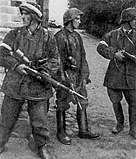| This article needs additional citations for verification. Please help improve this article by adding citations to reliable sources. Unsourced material may be challenged and removed. Find sources: "Union of Armed Struggle" – news · newspapers · books · scholar · JSTOR (November 2007) (Learn how and when to remove this message) |
| Part of a series on the |
| Polish Underground State |
|---|
 History of Poland 1939–1945 History of Poland 1939–1945 |
| Authorities |
|
Political organizations Major parties Minor parties Opposition |
|
Military organizations Home Army (AK) Mostly integrated with Armed Resistance and Home Army Partially integrated with Armed Resistance and Home Army
Non-integrated but recognizing authority of Armed Resistance and Home Army Opposition |
| Related topics |
The Union of Armed Struggle (Polish: Związek Walki Zbrojnej; ZWZ), also translated as the Union for Armed Struggle, Association of Armed Struggle, and Association for Armed Struggle, was an underground army formed in Poland following its invasion in September 1939 by Germany and the Soviet Union that opened World War II. It existed from 13 November 1939 until 14 February 1942, when it was renamed into Home Army (Armia Krajowa, AK).
Union of Armed Struggle was created from an earlier organization, Service for Poland's Victory (SZP). In January 1940, it was divided into two parts:
- areas under German occupation — commanded by Colonel Stefan Rowecki, headquartered in Warsaw;
- areas under Soviet occupation — commanded by General Michał Karaszewicz-Tokarzewski, headquartered in Lwów.
Formally, the Union of Armed Struggle was directed from Paris, by General Kazimierz Sosnkowski (nom de guerre Józef Godziemba), who after Poland's defeat escaped to France via Hungary. Due to practical problems, however, Sosnkowski's control of the organization was very limited. The instruction of General Sosnkowski, in which he ordered his subordinates to create regional branches of the Union of Armed Struggle, was brought to Warsaw on 4 December 1939. According to Sosnkowski, the Union of Armed Struggle was supposed to be a national military organization, without regard to political differences and social ranks. Furthermore, the idea of a national uprising at the moment of entry of regular Polish units was put forward by Sosnkowski and his staff.
After the fall of France, on 18 June 1940, General Władysław Sikorski named Colonel Stefan Rowecki his deputy, with the right to take urgent decisions without consent of the Polish government-in-exile. Sikorski urged Rowecki to closely cooperate with leaders of political parties, gathered in the Political Consultative Committee. The headquarters of the Union of Armed Struggle formally was under the authority of the Polish government in London, but in reality, military powers were in hands of officers who remained in the occupied country, and had good knowledge of the reality of Nazi- and Soviet-controlled Poland.
After the arrest of General Michał Tokarzewski-Karaszewicz, who was captured by the NKVD on the way from Warsaw to Lwów, the Union of Armed Struggle in Eastern Poland was left without a leader. Following the Operation Barbarossa, the whole territory of the Second Polish Republic found itself under German occupation.
See also
- Union of Active Struggle (founded 1908)
Notes
- Thus rendered in Norman Davies, God's Playground: A History of Poland, vol. II, p. 464.
References
- Norman Davies, God's Playground: A History of Poland, in Two Volumes; Volume II: 1795 to the Present, New York, Columbia University Press, 1982, ISBN 0-231-05353-3.
External links
- (in Polish) ZWIĄZEK WALKI ZBROJNEJ, Encyklopedia Interia
- (in Polish) ZWIĄZEK WALKI ZBROJNEJ, Encyklopedia PWN
- (in Polish) ZWIĄZEK WALKI ZBROJNEJ, Encyklopedia WIEM
- 1939-1942; Beginning of Secret Army; the ZWZ period
- (in Polish) „Polska Podziemna”: Związek Walki Zbrojnej